Galaxea Coral Care: Placement, Feed, Frag, Growth and Colors
- by Alison Yang
- January 19, 2024
- 21.7K views

Welcome to the space coral! Sorry, I mean the Galaxea coral! This beauty of the saltwater world is known for its aesthetic resemblance to the stars. Don’t let its good looks fool you since they are quite aggressive and have a few specific requirements to ensure a peaceful aquarium.
The benefits of corals in your tank is that they are not as delicate as many fish so you will be able to improve the appearance of your saltwater paradise without too much work (as long as you choose the proper tankmates).
This guide may not teach you about planets, but you will learn a lot about successfully caring for your Galaxea coral. Let’s dive in!

Quick Facts
Table of Contents
Species Summary
The Galaxea fascicularis (scientific name), commonly referred to as Galaxy coral, Tooth coral or Starbust coral, is a stony coral known for its unique appearance and aggressive nature. Native to the Indo-Pacific region, this species is admired for its intense coloration and challenging care.
When considering Galaxea for an aquarium, it’s essential to note that they possess sweeper tentacles that at night can extend up to twenty times, reaching 6 to 12 inches, contributing to their aggressive temperament when defending space.
No Spam, Subscribe for Cool Fish Stuff!
Endowed with both stunning beauty and a formidable presence, Galaxea Corals add a striking element to marine aquariums, provided their specific care requirements are met to ensure a healthy and thriving environment.
Galaxea Coral is recognized for its distinctive and expressive appearance. You will notice that it exhibits a variety of vibrant colors including green, purple, and blue. The polyps of this coral possess long, slender tentacles that can extend well beyond their base, giving the coral a fuzzy and bristled look, especially when fully extended.
In particular, Galaxea Coral tentacles often have contrasting white tips, which can add a striking visual effect to the coral’s overall appearance . Here are some notable features:
Tentacles: Typically long with potential for extended reach.
Colors: Ranges from green and purple to blue with the possibility of other hues.
White Tips: Many of the tentacles feature prominent white tips.
When caring for Galaxea Corals in home aquariums, owners enjoy their dynamic and textured presentation, which can serve as a captivating focal point.
Author Note: It’s vital for us to consider their aggressive growth patterns, as their appearance can change based on their surrounding environment and the space they have to expand.
The tentacles’ pulsating movement contributes to its unique and lively aesthetic, reinforcing why we regard Galaxea Corals as a visually engaging species in the marine aquarium hobby.
Popular Galaxea Coral Species
When it comes to maintaining a vibrant reef aquarium, the inclusion of Galaxea corals is a favored choice among enthusiasts. As specialists in the care of marine invertebrates, we’ve observed several sought-after species that exhibit both aesthetic appeal and adaptability to captive conditions.
- Galaxea fascicularis , commonly referred to as the Galaxy Coral or Tooth Coral, stands out as the predominant species in the Galaxea genus. It is famous for its star-like polyps and crystalline texture. What makes it appealing is its wide color palette, ranging from shades of green and brown to more exotic hues.
- The Battlestar Galaxea deserves a notable mention for its unique appearance. It exhibits a dynamic color contrast that can be spectacular under the right aquarium lighting conditions. Their polyps have a remarkable ability to catch light, creating a glistening effect that resembles a starry night sky.
- In the more premium spectrum, the Gold Galaxea Coral garners attention for its rare and exquisite golden polyps. Due to its unique coloration, it’s highly prized by coral collectors and often seen as a centerpiece in many reef tanks.
We emphasize that these species can be aggressive and possess extended sweeper tentacles . These are used to sting and keep competing corals at bay. Therefore, it’s crucial to provide sufficient space for each specimen in the aquarium to flourish and prevent altercations with other inhabitants.
Galaxea Coral Care
Caring for Galaxea coral involves specific requirements for tank size, water parameters, tank setup, and acclimation to ensure a thriving environment. Our guide provides a straightforward approach to maintain the health and growth of your Galaxea coral.
For Galaxea coral, a minimum tank size of 50 gallons is recommended due to their aggressive nature. While they may not need an entire galaxy, they do require ample space to expand without contacting other corals, as they may engage in chemical warfare with their neighbors.
Water Parameters
Proper water parameters are crucial for Galaxea coral health. Aim to maintain the following levels:
- Water Temperature : 75-82°F (24-28°C)
- pH Levels : 8.1-8.4
- Specific Gravity (Salinity) : 1.023-1.025
- Alkalinity : 8-12 dKH
- Calcium : 380-450 ppm
- Magnesium : 1250-1350 ppm
- Phosphate : <0.05 ppm
- Nitrate : <20 ppm
Conduct regular tests to ensure these parameters remain stable.
Make sure to consider what species you already have in your tank since the Galaxea coral could harm them, so plenty of space between them is recommended to keep a friendly aquascape. The following factors will also help keep a colorful coral for years to come.
Moderate lighting with a PAR level of 100-200 is ideal . Be cautious of high light intensity as it can harm the coral.
Filtration/Water Flow
Establish a strong filtration system with moderate water flow to mimic their natural habitat and keep the water clean. 20 to 40 times water turnover would be a good range to start with.
Substrate and Aquascaping
Use a mix of sandy substrate, island rock, or live rock to encourage natural behavior and growth. Ensure robust aquascaping to provide stability for the coral structure.
Acclimation
When introducing Galaxea coral to a new environment, a slow drip acclimation process is recommended to adjust the coral to the tank’s specific water conditions. This can take several hours but is crucial for the coral’s long-term health.
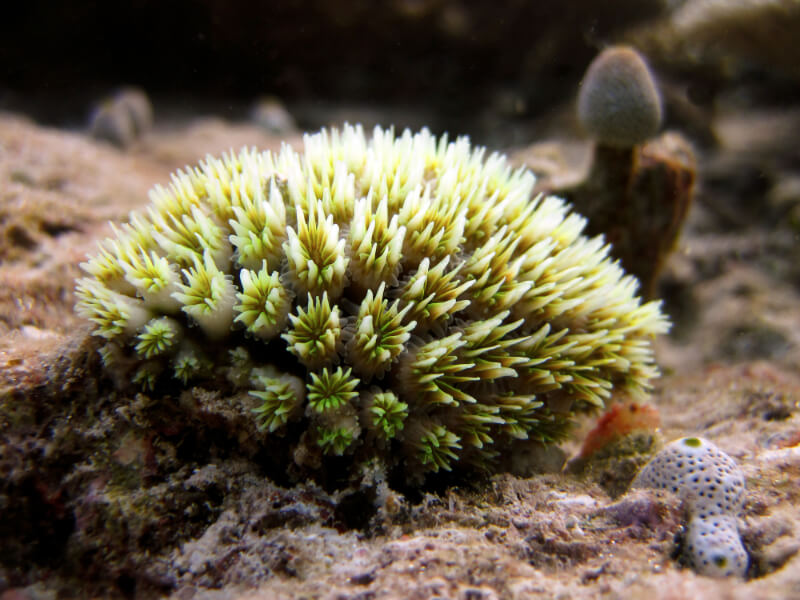
Growth Rate and Size
The Galaxea Coral exhibits a steady growth rate when kept in optimal conditions. Each polyp of this coral can reach up to 6mm in diameter . These corals have the ability to grow both vertically and horizontally across the substrate (that’s why we recommended plenty of space in the previous section).
When it comes to the growth rate, Galaxea Corals can expand their polyps and increase their size noticeably over the months. Here’s a snapshot:
- Tiny Frags : New fragments start off small and begin showing new polyp growth within weeks.
- Juvenile Colonies : Within several months, these frags can develop into small colonies.
- Mature Colonies : In a few years, a single frag can transform into a substantial colony that becomes a central feature in a reef tank.
Fortunately, fragging Galaxea corals is not extremely difficult as long as the following two tips are part of the process:
- Use a bone cutter or a frag saw for a clean cut and to minimize damage.
- Attach the fragment to a rock or a ledge far away from other corals.
Galaxea Corals are somewhat fragile, so make sure to handle them with extra caution during maintenance and fragging procedures. While they can endure fragging well, this process should be undertaken delicately to avoid damage.
In case you are looking to frag corals on a regular basis and need more detailed information, check our Coral Fragging Guide .
Author Note: It’s important to note that the size of a Galaxea Coral in captivity largely depends on tank conditions and space availability. Larger tanks allow for more significant growth, while captive corals in smaller aquariums may have restricted growth due to space constraints.
Galaxea corals receive most of their nutrients through their symbiotic relationship with photosynthetic algae, but it is recommended to supplement their diet with additional feedings for optimal health and growth.
Meaty Foods: Finely chopped seafood, such as shrimp or fish will be perfect for your coral to capture with its stinging tentacles. It’s important to provide these meaty foods in moderation to avoid polluting the tank. Feedings of this sort are best done 2-3 times per week.
- Beneficial Additives: To promote health, you can also try benepets which are reef-safe nutritional supplements. These provide a balanced mix of amino acids and other beneficial compounds vital for coral growth.
Powdered Coral Food: Another option is powdered coral food designed for LPS (Large Polyp Stony) corals. This can be mixed with tank water and introduced to the corals directly or broadcast into the tank, ensuring the coral has access to the nutrients.
Author Note: Be careful not to overfeed as this can lead to water quality issues. Watching how the coral reacts during feedings will give you insights into its health and will help you adjust the quantity and frequency of feedings accordingly. Moreover, strong water flow should be momentarily reduced during feedings to enhance the coral’s ability to catch and consume the food provided.
Compatibility and Tank Mates
Understanding the compatibility of Galaxea corals with other species is crucial. These vibrant members of the LPS (large polyp stony) corals possess a notably aggressive nature, primarily due to their sweeper tentacles.
Recommended Fish: Choose fish that don’t typically interact with corals like some from the list below.
- Blennies like the Scooter Blenny
- Damselfish (we like the Domino Damsel )
- Dartfish also known as Fire Dartfish
- Gobies (how about the Bumblebee Goby? )
- Hawkfish so try the Longnose Hawkfish
- Dwarf Lionfish
- Puffers (the Dwarf Pea Puffer is a good looking one)
- Wrasses like the Fairy Wrasse or the Christmas Wrasse
Other Corals: It’s crucial to provide ample space between Galaxea corals and other coral species to avoid contact with the Galaxea’s stinging tentacles. Hardy corals placed at a safe distance will work.
Invertebrates: Many invertebrates, such as Shrimp (like Cleaner Shrimp ), Snails , and Hermit Crabs , can coexist with Galaxea corals as they generally don’t interfere with corals. There are a few large starfish that might climb over and disturb the coral, so these should be avoided.
Starfish and Urchins: These can also be good companions as they typically don’t interact directly with corals.
Tank Mates to Avoid: There are fish that enjoy a nice meal of coral polyps so stay away from angelfish and butterflyfish . Moreover, small clams and certain types of worms might settle too close to the Galaxea coral running the risk of being stung.
The journey of caring for Galaxea corals is both rewarding and challenging, offering a splendid spectacle for any reef aquarium enthusiast. These corals, with their star-like polyps and radiant colors, not only enhance the beauty of your aquatic setup but also serve as a testament to your dedication and skill in reef keeping.
They might not be a starter coral due to its aggressive behavior but if you are up to the challenge, maybe start with just a few tank mates and go from there. This way you can slowly monitor the response of your coral and any new fish before it becomes a wild west with everyone fighting for survival.
Another cool LPS coral to learn about is the Lobo Coral which only needs a 10 gallon tank. We hope you enjoyed this guide and if you have any questions don’t hesitate to reach out to us . Ha! And don’t forget to tag us on Facebook when sharing good looking photos of your coral.
How to avoid bleaching of your Galaxea coral?
Adjust the position of the coral within the tank based on the lighting strength to avoid bleaching—lower placement for high-intensity lighting and higher positions for weaker lighting setups.
How to manage the aggressive sweeping behavior of Galaxea coral in a reef tank?
Maintain a distance of at least 6 inches and up to 12 inches from neighboring corals and creatures. This precaution minimizes the potential for damage caused by the coral’s defensive mechanisms.
What placement within the aquarium is best for Galaxea coral to thrive?
Position them on a rock or elevated ledge, adhering to the mentioned spacing guidelines to provide the moderate flow and lighting they need. These measures allow for proper waste removal and feeding.
Alison Yang
Alison is passionate about the intricate web of life on our planet, she's an Ecology and Evolutionary Biology graduate dedicated to creating impactful content that educates, inspires, and fosters change. As an educator, she has a proven track record of simplifying complex concepts, making them accessible to a broad audience. When she's not diving into the world of science or teaching, you can find her at the local animal shelter, offering her time to care for and advocate for our furry friends. Feel free to reach out to Alison to: [email protected]
You May Also Like
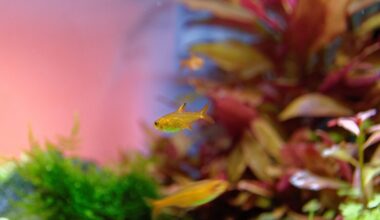
- 8 minute read
Ember Tetra 101: Care, Size, Breeding, Lifespan, & More
- October 4, 2022
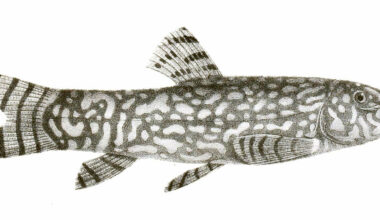
- 9 minute read
Yoyo Loach Care 101: Size, Tank Mates, Lifespan & More
- May 2, 2022
- Hammer Corals
- Leather Corals
- Mushroom Corals
- Torch Corals
- Invertebrates
Galaxea Coral Care – How to Grow This Aggressive LPS

The Galaxea Coral commonly referred to as the Starburst, Crystal, Star, Tooth, or Galaxy Coral is a beautiful LPS (large polyp stony) coral popular with beginners because of its hardiness.
Their colors are “out of this world” with awesome color combinations including tan, brown, green, pink, gray, purple, and many more! Perhaps that’s where they got their common name from, or from their long “alien-like” tentacles that can extend several inches at night. When keeping Galaxea Corals, you must note that they are aggressive. When active, your Galaxea will reach around, stinging and potentially damaging neighboring corals, which is why placement is key.
In This Article
- Common Name: Galaxea Coral
- Scientific Name: Galaxea fascicularis
- Family: Oculinidae
- Origin: Indo-Pacific
- Care Level: Moderate
- Temperament: Aggressive
- Lighting: Moderate-High (PAR 150+)
- Water Flow: Medium
- Placement: Any
Galaxea Coral Care
Galaxea Coral is a hardy coral that fits into a variety of aquarium setups. Even though they are a hardy LPS coral, extra care must be taken when handling them, as Galaxea Corals have a very fragile skeleton that can easily be damaged.
Galaxea Corals have been widely imported and aqua-cultured for aquarists as they tend to be much hardier than corals imported from the wild. They also seem to tolerate a variety of aquarium conditions, however, you should always keep the following water conditions within range.
Ideal Water Conditions
- Temperature: 72° – 78 °F
- pH: 8.1 – 8.4
- Salinity: 1.023 – 1.025
- Alkalinity: 8 – 11 dKH
- Nitrates: <10 ppm
- Phosphates: <0.10 ppm
- Calcium: 400 – 450 ppm
- Magnesium: 1200 – 1350
- Strontium: 8 – 10
Feeding Your Galaxea Coral
Galaxea Corals rely heavily on the symbiotic algae that live within their tissues, called zooxanthellae. You may not be able to see them, but they play a vital role in your coral’s health and nutrition.
The zooxanthellae that live inside your Galaxea Coral provide your coral with food and in return, the Galaxea Coral gives them a cozy home to stay protected from predators.
Although the zooxanthellae provide your coral with the nutrition they require to survive, your Galaxea will benefit from some meaty foods 2 to 3 times a week. You can give them a variety of planktonic coral foods, brine shrimp, mysis, anything meaty that will fit in their mouths. Galaxea Corals will also benefit from some supplements, just like how vitamins benefit your health. Additional calcium, strontium, and trace elements will help build their exoskeleton, enhancing their growth!
Galaxea Coral Placement
With such beautiful coral like the Galaxea, I am sure you will want to show it off, but there are a few things to consider before you add it to your aquarium.
Because of their aggressive nature, your Galaxea will appreciate being placed on an island rock away from neighboring corals. This gives them a unique position in your aquarium and ensures neighboring corals are safe from their long sweeper tentacles. As their tentacles can extend at least 4 inches during the evening, ensure you leave at least 6 inches (12 inches recommended) between other corals otherwise they will start chemical warfare, and your Galaxea will most likely win…
Placement for your Galaxea coral also depends on the lighting you provide. When kept under moderate lighting, you should place your Galaxea in the middle to the top part of the aquarium reef. If you opt for higher lighting, then you should place your coral between the middle and lower region of the reef, and if your aquarium has very intense lighting, they will best be placed on the substrate.
Galaxea Coral Aggression
As mentioned, your Galaxea Coral is notorious for its long sweeper tentacles that can sting neighboring corals. To minimize aggression, give your coral plenty of space for them to extend their tentacles without nearby corals falling victim to their powerful sting.
Remembering to feed them meaty treats is also a good way to prevent them from stinging other corals. If they have a full tummy they will spend less time searching for food with their stinging tentacles.
Galaxea Coral Sweepers & Water Flow
Water flow plays an important role in your Galaxea coral’s sweeper tentacles. The stronger the water flow, the longer their sweeper tentacles usually extend, but do not blast the water flow directly at them, as they may close up. If you keep the water flow low to moderate your Galaxea may only extend their tentacles around 1-2 inches.
So, for your Galaxea to thrive, varied medium water flow with random bursts is best. Providing this water flow pattern will remove waste products generated by organisms in your aquarium and bring enough feeding opportunities for optimum growth and coloration for your Galaxea Coral.
Galaxea Coral Lighting & PAR
Compared to SPS (small polyp stony) corals, Galaxea Corals do not require as much light and can live in a variety of lighting conditions. Unlike most corals, your Galaxea Coral can be kept under regular fluorescent lighting and still stand out from the crowd!
You must however alter their placement depending on the lighting you have. If you have chosen Metal Halides, it is recommended to place your Galaxea Coral in the low to the middle region on the reef, and with other lighting fixtures such as T5’s and LEDs, place the Galaxea between the middle and higher region.
Galaxea Coral Growth Rate – How Fast Will Your Galaxea Coral Grow
Expect your Galaxea coral to grow pretty fast! These corals do not hang around when it comes to spreading out, however, if you are having problems with their growth, feeding often speeds up the process.
Some hobbyists have issues with their Galaxea taking over inside the aquarium. If this happens you can try to chip off parts of the colony, however, as they are full of nasty biological warfare proteins, be prepared for many water changes. An alternative would be to remove the colony and cut parts off outside the aquarium. Do not worry, they will be fine exposed while you do that. With the cut-off frags, you can give them to a friend or sell them.
Galaxea Coral Not Opening
Firstly, many corals do not open 24 hours a day, so monitor them for a couple of days or set up a camera, as you may be sleeping when they decide to open up.
Secondly, check your water parameters and perform a water change if needed.
If they continue to close their polyps, you may want to move them further up in the aquarium, so they can receive more light. Also check you are not blasting them with too much direct water flow, as your coral may not open fully to protect their polyps. Remember that Galaxea corals are very easy to become damaged as their tentacles and skeleton are very sensitive.
Galaxea Coral Dying
Galaxea Corals do not die for no reason. This coral is prone to brown jelly infections, STN/RTN (slow tissue necrosis/fast tissue necrosis), and tissue recession when they become weak. To prevent this, check your coral’s health and place it in a coral dip before adding it into the aquarium for the first time.
Although rare, in severe cases the following issues can result in your Galaxea Coral dying:
- Excessive debris and waste collecting between their polyps.
- Breaking of their skeleton, exposing their tissues to infections, and compromising their immune system.
- Incompatible fish (usually parrotfish and angelfish are the culprits!) that will munch on your coral’s tissue.
- Transport – stress, and damage can kill your Galaxea Coral, therefore keep your coral’s polyps clean and use a coral dip before you place it inside the aquarium.
On a more positive note, your Galaxea’s polyps have wide spacing between one another, so if one polyp becomes infected or dies, then there is some hope of saving the whole colony.
Whether you are a new hobbyist looking for a coral that’s easy to care for, or you are a reef expert after a coral that has an “out of this world” appearance, the Galaxea Coral ticks both those boxes!

I have an unhealthy obsession with reef keeping and maintaining successful tanks. If you haven't noticed from the website, I love everything related to saltwater tanks like coral, fish, and everything else in between.
Leave a Comment Cancel reply
Save my name, email, and website in this browser for the next time I comment.
Helping you to set up and maintain a healthy and beautiful saltwater reef aquarium.
© Reef Tank Advisor 2021

Para cada presupuesto, un destino…
Ofrecemos una amplia variedad de ofertas y destinos, desde aventuras por carretera hasta emocionantes viajes en avión..
Encuentra la opción perfecta para ti…
Llena el formulario para recibir una Cotización Personalizada
Podemos organizar tu viaje cuando quieras 👌 Es posible contratar solo un servicio o puedes contratar en paquete y ahorrar 💲 en tus Vacaciones!!! Llena el siguiente formulario📃 , al dar click en enviar nos llegarán tus respuestas vía WhatsApp Un ejecutivo 🙋♀️ te enviará 3 opciones en base a tus respuestas ¡Recuerda, mientras más sepa, mejores opciones para ti! ❤️ ¡Gracias por considerar a Coral Tours para tus viajes!
Número de Adultos (*)
Número de menores ¿Cúal es su edad?
Buscar Hotel/Destino (*)
Fecha de llegada - Fecha de salida (*)
Tipo de hotel (*) ¿Qué tipo de hospedaje buscas? Sólo habitación Desayuno incluido Alimentos y bebidas (Todo incluido) Todas las anteriores
Presupuesto (*) ¿Cuánto quieres gastar? Hasta $5,000 Hasta $15,000 Hasta $25,000 Más de $25,000
¿Algun comentario o petición, buscas traslados? cuéntanos aquí
Se requerirá de Whatsapp móvil o web para enviar el mensaje
¿Prefieres un paquete ya armado?
Viajes populares, más vendidos.

PROMO Vallarta Todo Incluido + Avistamiento de Ballenas

PROMO Cancun Todo Incluido en Avión

Mazatlán 24 hrs. Todo Incluido – Hotel RIU

Charter Salidas a Manzanillo en Autobús
Ver paquetes, confirma y controla tu reserva en un click:, nuestro portal de clientes te brinda total confiabilidad..
Verifica cada pago realizado y realiza nuevos pagos de manera segura y conveniente.
Calificaciones de nuestros clientes
Jaqueline estefanía rojas de luis, mi experiencia con la agencia fue grata, muy amables, resolvieron dudas y estuvieron al pendiente en todo momento. excelente servicio, recomiendo viajar con coral tours☺️….
A todo dar con Coral tours hacen un ambiente agradable, en ningún momento son groseros, todo lo contrario tienen una vibra fiestera y eso me agrada. En cuestión de que tengas tiempo de salir de vacaciones, les recomiendo. Sin van de vacaciones vayan con la mentalidad de divertirse y arriesgarse hacer algo distinto en su vida, no vayan a dormir o estar siempre de malas. Váyanse a divertirse con Coral Tours. Les aseguro un viaje inolvidable. 👌🏾
Encantada con el servicio brindado por parte de esta agencia, su personal amable y es una experiencia sensacional, divertida en compañía del staf. Volvería a elegir un tours con ustedes ✨✨✨✨👍🏽 Mil gracias….
Dannia Ofelia Guerrero Garcia
Gran experiencia de viaje, fue mi primer viaje con ellos y todo estuvo excelente, la atención, el autobús, todo se hizo con seguridad y siempre respondieron nuestras dudas. Me gusto mucho. 🌿….
¿Por QUÉ ELEGIRNOS?
Viaja sin preocupaciones económicas.
Puedes reservar tus aventuras con un pequeño anticipo y pagar cómodamente cada quincena. ¡Viajar nunca fue tan fácil!
ELIGE COMO PAGAR
Te damos la libertad de elegir. Contamos con todos los métodos de pago tradicionales y en línea para que tu experiencia sea tan flexible como tus sueños de viaje.
PLANEA TU VIAJE, JUSTO COMO LO IMAGINAS
Explora nuestros itinerarios detallados directamente en nuestra página web. Reserva tus actividades y alojamientos en un solo lugar, simplificando cada paso de tu viaje.
ESCÁPATE A:
Puerto vallarta, dos salidas semanales, ixtapa zihuatanejo, salidas diarias.
Gladex Travel and Tours Corp.
Best known for its unique, excellent and quality service.

WELCOME TO GLADEX TRAVEL & TOURS CORP.
We offer the following services:.
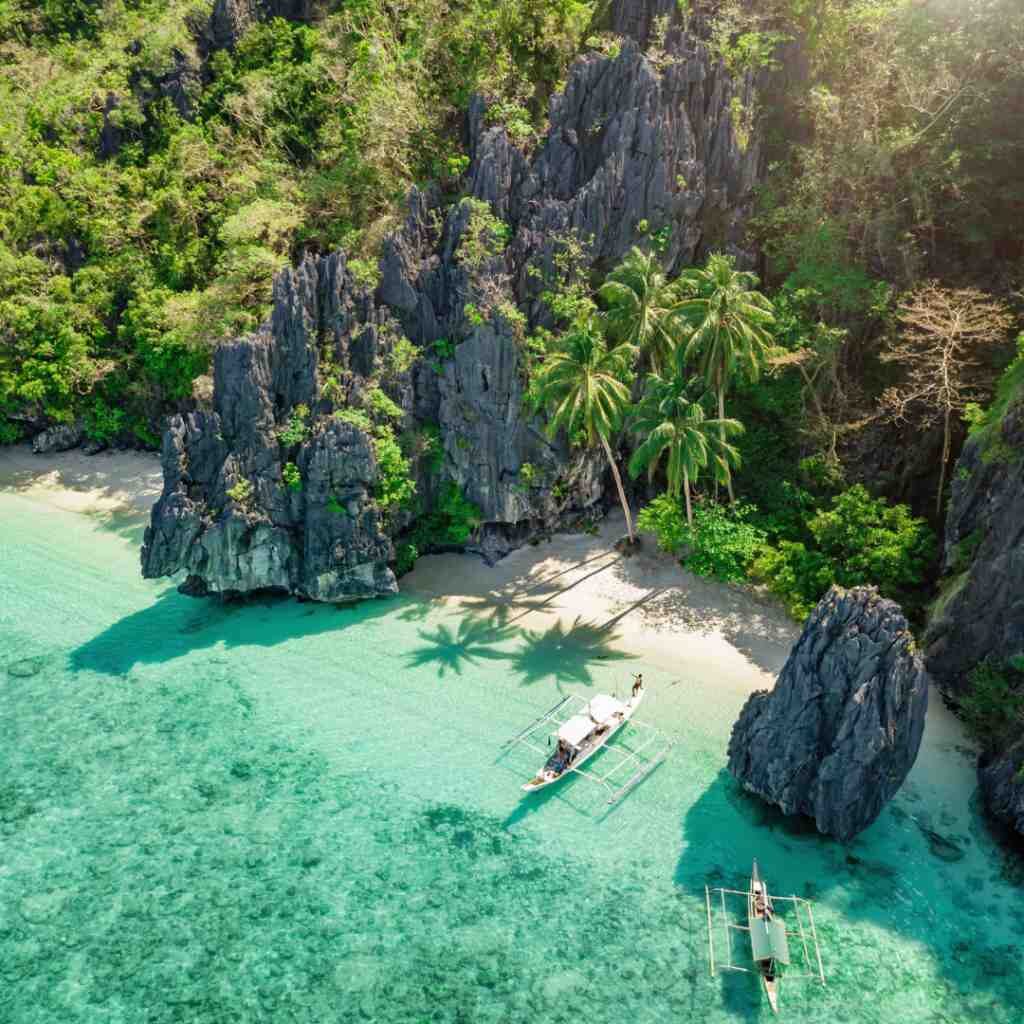
LIMITED TIME OFFERS

3D2N BOHOL PACKAGE 1: FREE & EASY (NO TOUR)


3D2N CORON PACKAGE 1: FREE & EASY

3D2N DAVAO PACKAGE 1: FREE & EASY (NO TOUR)

3D2N SIARGAO PACKAGE 1: FREE & EASY

3D2N PUERTO PRINCESA PACKAGE 1: FREE & EASY (NO TOUR)

3D2N BORACAY PACKAGE: BUDGET INN HOTELS

3D2N EL NIDO PACKAGE 1: FREE & EASY (NO TOUR)

INTERNATIONAL DESTINATIONS

3D2N KUALA LUMPUR PACKAGE 2: CITY TOUR + GENTING + FREE BATU CAVES PHOTO STOP

3D2N BANGKOK PACKAGE 1: FREE & EASY

3D2N HONGKONG PACKAGE 2: DISNEYLAND WITH FREE CITY TOUR BUDGET HOTELS

OPTIONAL TOUR: MANILA WHOLE DAY TOUR

OPTIONAL TOUR: MANILA HALF DAY TOUR

6D5N USA PACKAGE 1: EAST COAST

4D3N BANGKOK PACKAGE 2: PHUKET FREE & EASY
4d3n bangkok package 1: free & easy.

4D3N HONGKONG PACKAGE 5: W/ FREE CITY TOUR & MACAU CITY TOUR 5* HOTELS
Visa assistance.

Client Feedback
Thank you for giving us good feedback.

Privacy Overview

Free Biltmore Hotel historic tour in Coral Gables
The City of Coral Gables known as “The City Beautiful” is a wonder of Mediterranean architecture and rich history.
One of its most iconic and beloved sites The Biltmore Hotel is a 1920s marvel and a shining example of historic preservation so who better to host free weekly guided tours there than Dade Heritage Trust.

For more than 40 years the organization has been leading the charge cultural, architectural and historic preservation.
Tours are every Sunday at 2 p.m., led Dade Heritage Trust guides. Meet the guide at the fireplace at the east end of the Main Lobby for a walking tour of the hotel. The tour focuses on the architecture, history and cultural heritage of the Biltmore Hotel.
The National Landmark Hotel is at 1200 Anastasia Avenue in Coral Gables. Participation is limited to 20 , please register in advance by clicking here.
To keep up with latest news, sign up for the daily Miami on the Cheap newsletter. You can also follow us on Facebook , Twitter and Instagram .
Other events and things to do in coral gables:.
Family Day on Aragon
Gables Gallery Night
Floral park in Coral Gables
More Miami-Dade events
Biltmore hotel.
1200 Anastasia Avenue Coral Gables , FL 33134 (855) 311-6903
Visit Website Get Directions
Quick Links
Miami-dade events and deals.
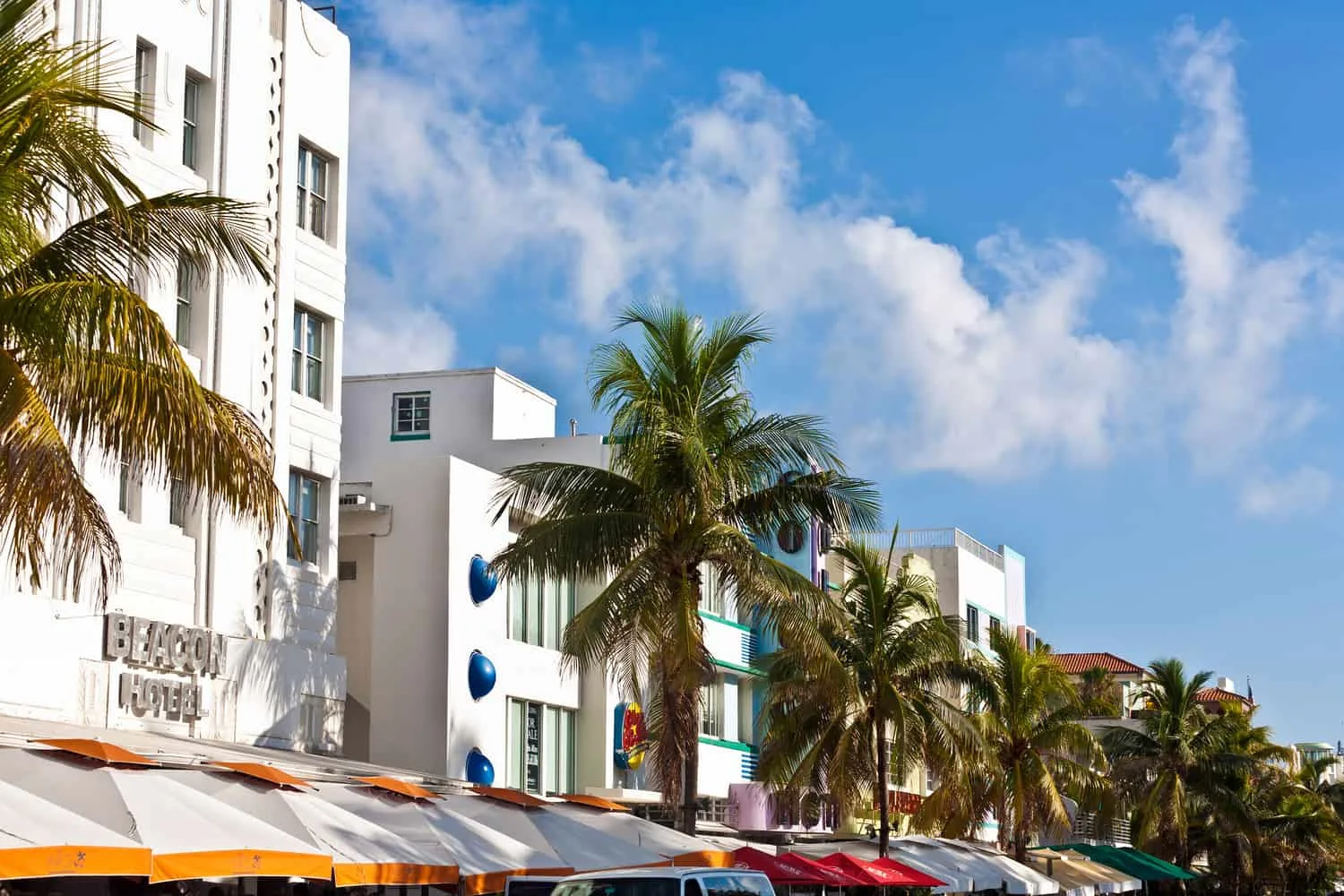
Find deals and things to do in Miami-Dade, from Aventura to Homestead, Doral to Coral Gables and more.
Miami-Dade Events & Deals
Broward Events & Deals
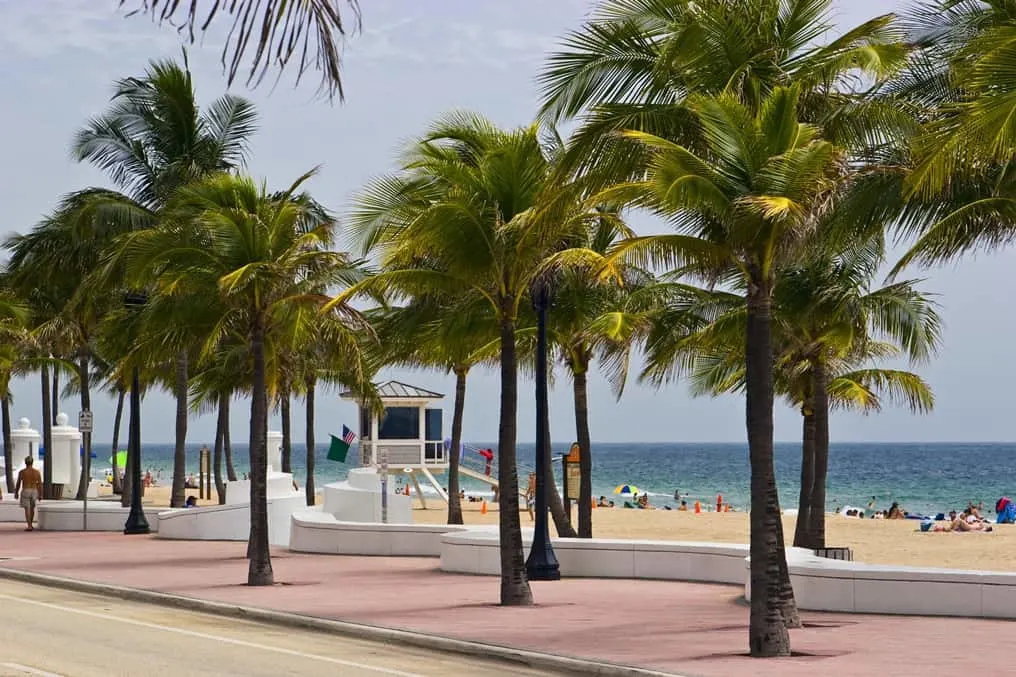
Find deals and things to do in Broward, from Hallandale Beach to Pembroke Pines to Pompano Beach.
Broward Deals & Events
Palm Beach Events & Deals
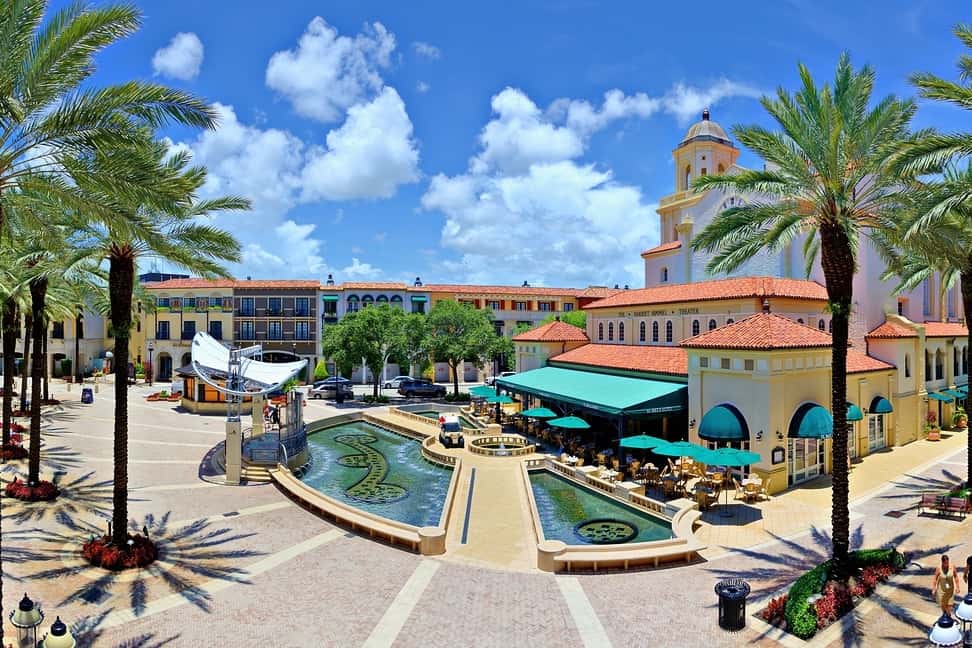
Find fun in Palm Beach County. Find beaches, attractions, concerts and more, plus deals and discounts.
Palm Beach Events & Deals
Orlando on the Cheap
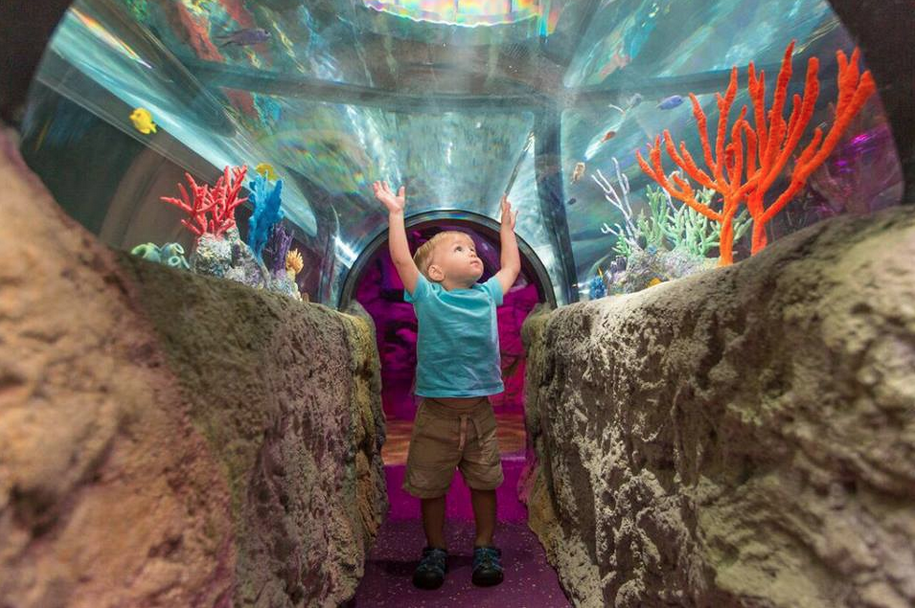
Find discount tickets to theme parks, things to do with kids and hidden gems in and around Orlando.
Orlando Tips & Deals

Living on the Cheap
Atlanta on the cheap, charlotte on the cheap, chicago on the cheap, columbus on the cheap, mile high (denver) on the cheap, hawaii on the cheap, kansas city on the cheap, madison on the cheap, miami-south florida on the cheap, myrtle beach on the cheap, new york city on the cheap, phoenix on the cheap, portland living on the cheap, rva (richmond) on the cheap, greater seattle on the cheap, southern maine on the cheap, triangle on the cheap (north carolina), vegas living on the cheap.
- Privacy Policy
- Submit Your Events
- List Your Business

GABLES BIKE TOURS
Third sunday of every month, 10 am.
Join us for fun, educational bike tours through The City Beautiful. Each tour offers a different theme and route! Tours start at the Coral Gables Museum and include museum admission. Bike tours are presented by Bike Walk Coral Gables in partnership with the Coral Gables Museum. You will need to bring your own bike. Helmets are required for children under 16.

Please fill out the form and include the signed waiver below or call the Museum to RSVP | Download Bike Tour Waiver
Approximately 2 hrs | $10; $5 for Museum members and children under 12
- January 21: The Villages
Did you know that City of Coral Gables Founder George Merrick planned 14 international themed villages for Coral Gables, but only seven were built? You will be amazed at the architectural styles from around the world that exist right here in our own backyard.
- February 18: Salt and a Peppering of History in South Miami
Join us for this bike tour through the City of South Miami with a focus on historic places and green spaces and a final stop at the Salty Donut for a sugary snack provided by Dade Heritage.
March 17: Living with Water Tour
South Florida is vulnerable to storm surges, king tides, and potential sea level rise, and Coral Gables is preparing for the time when we may see more water more often. Our tour guides from Miami-Dade County and the City of Coral Gables will lead us to see some of the most vulnerable locations in Coral Gables, where we will learn how we can manage flooding from tides, storms, and other water events in the future.
April 21: Bike and BBQ/Gables Cycle Day
Join us for the most popular bike tour of the year: a ride to Matheson Hammock Park and picnic at the historic pavilion. This tour leaves from the Coral Gables Youth Center (405 University Dr, Coral Gables, FL 33134). Presented in partnership with the City of Coral Gables and Dade Heritage Trust.
*This is a long ride (11.5 miles) and not recommended for small children.*
May 19: Literally Coral Gables
It’s no fiction, the literary history of Coral Gables includes book shops, libraries and even a few writers. Mitch Kaplan, the owner of Books & Books, will lead the first edition of this novel tour of the written word in Coral Gables.
June 16: Royal Poinciana Fiesta
Celebrate the magnificent Flame Tree on this tour of our best Royal Poincianas in full flower. Presented with the Tropical Flowering Tree Society as part of the annual Royal Poinciana Fiesta festival. Presented in partnership with the Dade Heritage Trust.
- July 17: Cool Canopies
Coral Gables is an international city, and that includes our trees. Take a comfortable ride to see how our greenest residents are saving water, fighting climate change and making our streets beautiful. We speak for the trees. Presented with Dade Heritage Trust.
July 21: Cool Canopies Tour
Enjoy a leisurely ride down some of Gables’ shadiest streets! On this tour, guided by a local expert, you will learn about the lush treescape that makes Coral Gables the “City Beautiful”. We will still be able to enjoy the Royal Poincianas in full bloom! Qué bonitas!
- August 18: Arboretum and Palmetum Tour – UM
We will ride to the Gifford Arboretum, a botanical garden located on the UM Campus, where we will view some of the over 500 species of trees and palms. This is the perfect shady destination for an August bicycle ride.
September 15: Tour of Parks/Gables Cycle Day
On this tour we will be traveling into space. Open space. The founders of Coral Gables knew that people want safe, beautiful places to be outside and to get close to nature. Come with us to visit some of the oldest and newest spaces in the City.
October 20 Pinewood Cemetery
Join us as we take a ghoulish tour through the Pinewood cemetery, the oldest cemetery south of the Miami River and the final resting place of many of Dade County’s earliest pioneer settlers. This spooky cemetery features original tombstones and unmarked graves from early Florida pioneer times amidst a beautiful pine rock land habitat. Zombie attire encouraged!
November 17: Trek to Girl Scouts Camp Mahachee on Old Cutler Road
We will take advantage of cooler weather to take this long ride to Camp Mahachee, a Girl Scout Camp in beautiful hammock near Matheson Hammock and Fairchild Garden. Our guide will take us a tour of the property and share the history and the plans for wonderful property.
December 15: Homes for the Holiday
Get into the spirit! On this ride we visit the Gables’ most festive holiday decorations including Merrick Park, Biltmore Way, Coral Gables Methodist Church, and the Coral Gables Merrick House.
Purchase Bike Tour Tickets
" * " indicates required fields
The Historic Riviera
- Name * First Last
- Subject * General Inquiries History Exhibitions Education Events
coralgablesmuseum
1,955 10,479
The City Beautiful’s Premier Hub of Civic Arts. #coralgablesmuseum


- Exploring Israel: Around The Sea of Galilee
- When is the Best Time to Visit Israel?
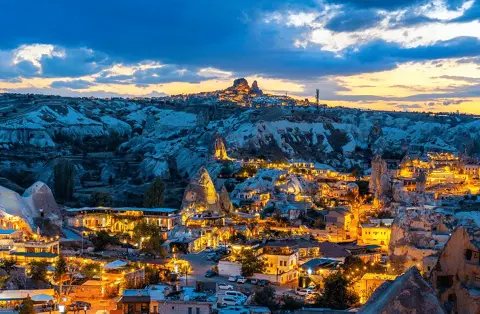
Israel, a land of profound historical and spiritual significance, offers an array of experiences that cater to the heart, soul, and senses.
At the heart of its many attractions lies the Sea of Galilee, a serene freshwater lake known for its history and breathtaking landscapes.
This picturesque region is not just a pilgrimage destination but a place where history, culture, and beauty blend seamlessly, offering a unique journey for every traveler.
The Alluring Sea of Galilee
The Sea of Galilee is a natural wonder and a treasure trove of history. The area around the lake is dotted with archaeological sites and ancient towns that tell the story of the region’s rich past.
From the remains of ancient Capernaum and the historic city of Tiberias to the lesser-known ruins scattered along its shores, the lake offers a glimpse into the lives of those who have inhabited its banks over millennia.
These sites provide fascinating insight into the cultures and civilizations that flourished in this area from biblical times through the Roman era and into the modern age.
Tranquility atop the Mount of Beatitudes
The Mount of Beatitudes, with its serene ambiance and stunning landscapes, is a testament to natural beauty and historical significance.
This tranquil hilltop overlooking the Sea of Galilee and the Golan Heights offers panoramic vistas and a profound sense of peace that captivates every visitor.
The area’s allure is magnified by the blend of historical architecture, lush gardens, and uninterrupted views of the surrounding countryside.
Architectural Elegance and Historical Significance
The architectural marvel created by Antonio Barluzzi in 1938 plays a significant role in defining the character of the Mount of Beatitudes.
Barluzzi, known for contributing to the Holy Land by designing several vital buildings, applied his masterful approach to harmonize with the natural surroundings.
His design for the site, which eschews overt religious symbolism for a focus on universal beauty, stands as a shining example of early 20th-century architectural elegance. Mindful of the area’s historical context, the structure offers a space that complements the site’s natural tranquility.
A Haven of Natural Beauty
The gardens surrounding the Mount of Beatitudes enhance the site’s peaceful atmosphere, offering visitors a lush, verdant space to wander or sit in contemplation.
These gardens are meticulously maintained and feature a variety of plants and flowers that thrive in the region’s climate.
The paths that meander through the gardens are designed to offer visitors various perspectives of the Sea of Galilee below, framing the natural beauty of the lake and its surroundings with the vibrant colors of the flora.
Panoramic Vistas
The breathtaking view is one of the most compelling reasons to visit the Mount of Beatitudes. From this vantage point, one can gaze upon the vast expanse of the Sea of Galilee, with the undulating Golan Heights rising in the distance.
The panoramic vistas available from the mount are unparalleled. They offer a visual feast stretching from the lake’s azure waters to the rugged landscapes beyond. These views provide a magnificent backdrop for reflection and allow visitors to appreciate the sheer beauty of Israel’s natural landscape.
Historical Richness of Tabgha
Tabgha, nestled on the northwestern shore of the Sea of Galilee, embodies the intricate tapestry of Israel’s history, nature, and culture.
This tranquil spot, characterized by its lush surroundings and ancient olive groves, has been a focal point of human activity and spiritual significance for millennia.
The area’s historical richness is evident through its archaeological sites and the remnants of structures that paint a vivid picture of life in ancient times.
Archaeological Significance
Tabgha’s archaeological findings have provided invaluable insights into the region’s historical and religious development. The area is known for the remains of Byzantine-era churches, built to commemorate the New Testament events believed to have taken place here.
Among these, the remains of the Church of the Multiplication stand out. Its beautifully preserved mosaic floor depicts loaves and fishes, symbolizing one of Jesus’s miracles.
The site’s excavations reveal complex settlement layers, from Byzantine constructions to earlier Jewish and Roman habitation, illustrating the diverse cultural and religious communities that have left their mark on the landscape. These findings shed light on the architectural styles, daily life, and spiritual practices of the people who lived in and around Tabgha through the ages.
Agricultural Heritage
Tabgha’s fertile land and proximity to the Sea of Galilee have made it a rich agricultural area, historically significant for its olive groves and fishing.
The ancient olive trees in Tabgha are living relics of the region’s farming practices, which have been sustained for generations. These trees contribute to the area’s natural beauty and symbolize the enduring relationship between the land and its inhabitants.
The region’s agricultural development is closely tied to its historical and societal evolution. The cultivation techniques, irrigation systems, and land management practices adopted in Tabgha and the surrounding areas reflect the adaptability and ingenuity of its people in harnessing the region’s resources. These practices have shaped settlement patterns and societal structures throughout history.
Capernaum’s Historical Insights
Capernaum, often referred to as the “Town of Jesus,” holds a special place in the historical and cultural fabric of the Galilee region.
Situated on the northern shore of the Sea of Galilee, this ancient fishing village has been the focus of archaeological studies that have unearthed significant insights into life during its peak habitation.
Its strategic location and the archaeological findings tell a story of several centuries of economic, social, and religious importance.
Economic Foundations and Daily Life
Capernaum’s economy was primarily based on fishing, with its proximity to the Sea of Galilee providing abundant resources for the local inhabitants. The discovery of ancient homes, public buildings, and fishing implements in the area offers a clear picture of a bustling community centered around the fishing industry.
The remains of ancient olive presses and agricultural tools also suggest a diversified economy that included farming and olive oil production, which is crucial for daily life and trade.
The village’s layout, with its houses built from basalt stones and narrow streets, reflects a closely knit community where families lived in close quarters, sharing the burdens and bounty of their labor.
These homes and public spaces, such as the village synagogue, were central to the social and religious life of the inhabitants, serving as gathering places for worship, education, and community decision-making.
The discovery of the Synagogue of Capernaum, believed to be one of the oldest synagogues in the world, highlights Capernaum’s archaeological significance.
The remains of this impressive structure, with its ornate stone carvings and columns, indicate the community’s wealth and its central role in religious and social gatherings. The synagogue is a testament to the region’s religious diversity, where Jewish and early Christian communities coexisted and influenced each other.
Adjacent to the synagogue, the remains of what is believed to be the house of Saint Peter have been uncovered, further underscoring Capernaum’s significance in early Christian history. The site, over which a modern church now stands, offers a unique glimpse into the early Christian community’s life and its transition from Judaism.
Cultural and Historical Development
The artifacts and structures unearthed in Capernaum provide a window into the cultural exchanges that occurred in this region. The variety of pottery, coins, and household items at the site reflect the influence of Roman, Byzantine, and early Islamic cultures, showcasing the village’s role as a crossroads of civilizations.
Capernaum’s decline and eventual abandonment are part of its historical narrative, reflecting the region’s changing political, economic, and environmental conditions. However, its rediscovery and excavation have allowed historians and archaeologists to piece together its past, offering valuable lessons about the resilience and adaptability of its inhabitants.
Golan Heights: A Landscape Shaped by History
The Golan Heights, a plateau of strategic significance and stunning natural beauty, offers a unique lens to view the Middle East’s layers of history, geopolitics, and cultural shifts. This region, known for its rugged terrain, has been the subject of international focus since its capture by Israel in the 1967 Six-Day War, illustrating the complex interplay of military, political, and cultural factors in shaping its identity.
Strategic Importance and Historical Conflicts
Historically, the Golan Heights has served as a crucial strategic vantage point due to its high elevation overlooking the Jordan Rift Valley, including the Sea of Galilee. This strategic importance has made it a contested region throughout history, with various empires and states seeking control to secure their borders and monitor enemy movements.
The area’s significance was underscored during the 1967 and 1973 wars, where it played a central role in the conflicts between Israel and Syria. Its capture and subsequent annexation by Israel, recognized by some countries and disputed by others, highlight the ongoing geopolitical tensions in the region.
A Tapestry of Civilizations
The Golan Heights is also a mosaic of cultures and civilizations that have left their mark over millennia. Archaeological sites scattered across the plateau tell the story of ancient cities, Roman and Byzantine ruins, and medieval fortresses.
These remnants bear witness to the diverse groups that have inhabited the region, from the biblical cities of the Geshurites to the strategic outposts of the Ottoman Empire. The diversity is further reflected in the Druse communities that call the Golan Heights home, maintaining their unique cultural heritage amidst the region’s changing political landscape.
Natural Splendor and Conservation
Amid its tumultuous history, the Golan Heights boasts breathtaking natural beauty. Its landscapes range from the basaltic plateaus to lush valleys, waterfalls, and the volcanic Mount Hermon, Israel’s highest peak.
The region’s biodiversity is preserved in several nature reserves and national parks, where visitors can witness the beauty of the Banias Waterfall, the majesty of the Yehudiya Forest Reserve, and the tranquil waters of Lake Ram.
These natural attractions not only draw tourists but also serve as reminders of the importance of environmental conservation and the potential for nature to bridge divides.
Resilience and Adaptability
The story of the Golan Heights is one of resilience and adaptability. Despite the challenges of conflict and political uncertainty, the region thrives, with its communities finding ways to coexist and its natural beauty preserved for future generations. The development of agriculture, particularly wine production, has become a symbol of this resilience, with Golan Heights wineries gaining international acclaim for their quality.
A Window into the Middle East’s Complex Past
The Golan Heights offers a window into the complex tapestry of the Middle East’s past, blending the beauty of nature with the scars of history. It stands as a testament to the region’s strategic importance, the cultural richness of its inhabitants, and the enduring hope for peace and stability.
From the serene overlooks facing the Sea of Galilee to the poignant reminders of past conflicts, the Golan Heights remains a powerful symbol of the multifaceted narrative that defines this storied land.
Outdoor Adventures
The Sea of Galilee, a gem in the heart of Israel, is a site of historical and cultural significance and a haven for outdoor enthusiasts.
Surrounded by a landscape ranging from gentle hills to rugged cliffs, the area invites adventurers and nature lovers to explore its beauty in many exhilarating ways.
Hiking and Exploration
The region is crisscrossed with trails suited to all levels of hikers. Among the most notable is the journey to the Arbel Cliffs. This trail offers more than just a hike; it explores history and nature, leading adventurers to breathtaking overlooks of the Sea of Galilee and the Golan Heights. The cliffs present a dramatic landscape, with steep drops and ancient fortresses carved into the rock, telling tales of rebels and Romans.
For those looking for a less strenuous but equally rewarding experience, the Jesus Trail connects significant historical sites from Nazareth to Capernaum, offering diverse scenery, including mountaintop views, agricultural fields, and urban landscapes.
Water Sports and Activities
The Sea of Galilee’s calm and clear waters make it ideal for various water sports. Kayaking and stand-up paddle boarding offer peaceful ways to traverse the lake, providing unique vantage points of the surrounding landscapes and a chance to cool off during the warm months.
Windsurfing is another popular activity, with the lake’s mild climate providing good conditions for both beginners and experienced windsurfers. Several local outfitters around the Sea of Galilee offer equipment rentals and lessons for those eager to catch the wind in their sails.
Of course, swimming is a favorite, with numerous beaches around the lake offering sandy shores and designated swimming areas. The Tiberias Hot Springs on the western coast also offers a chance to soak in mineral-rich waters acclaimed for their therapeutic qualities since Roman times.
Biking Around the Sea
Cycling enthusiasts will find the Sea of Galilee a perfect place to ride. Routes range from leisurely paths along the shore to challenging off-road trails that ascend the surrounding hills. Biking provides a beautiful way to explore the area at your own pace, with the freedom to stop at beaches, historical sites, and viewpoints.
Bird Watching
The Sea of Galilee sits along the migratory path between Europe and Africa, making it an excellent spot for bird watching, especially during the migration seasons in spring and autumn. The Hula Valley, just north of the lake, is one of the best places in the world to observe migrating birds, including cranes, storks, and pelicans.
While the Sea of Galilee is historically known for its fishing, enthusiasts can still enjoy casting their lines in its waters. The lake is home to various species, including St. Peter’s fish (tilapia), catfish, and carp. Fishing offers a quiet, contemplative way to connect with the lake’s natural environment, echoing the centuries-old traditions of the region.
The Sea of Galilee region offers adventure, relaxation, and natural beauty, catering to outdoor enthusiasts of all tastes. Whether hiking the ancient paths, gliding across the water, or simply enjoying the tranquil shores, the area promises a memorable experience amidst one of Israel’s most beautiful landscapes.
Culinary Delights and Local Culture
The culinary landscape around the Sea of Galilee is as rich and diverse as the area’s history and natural beauty. This fertile region, blessed with abundant sunshine, fresh waters, and rich soil, offers a bountiful harvest that feeds into the local culinary traditions, making it a haven for food lovers. The gastronomic delights found here reflect the area’s agricultural prowess and the melting pot of cultures that have influenced the region throughout history.
A Bounty of Fresh Produce and Seafood
The Sea of Galilee region is renowned for its fresh produce, with local farms and kibbutzim cultivating various fruits, vegetables, and herbs. Markets brim with the season’s best, from juicy citrus fruits to crisp vegetables and aromatic herbs, all playing a starring role in the local cuisine. The lake is a source of fresh fish, most notably the St. Peter’s fish (Tilapia), a staple in local dishes and often grilled or fried in lakeside restaurants.
Culinary Traditions and Innovations
The culinary offerings around the Sea of Galilee testify to the region’s rich cultural tapestry. Traditional dishes often passed down through generations are prominently featured on menus, showcasing the flavors and spices characteristic of Middle Eastern cuisine. Hummus, falafel, tabbouleh, and baba ganoush are just some staples that locals and visitors alike savor.
Moreover, the region’s chefs and home cooks alike are unafraid to innovate, blending traditional recipes with contemporary techniques and global influences. This fusion results in a dynamic culinary scene that respects tradition while embracing modernity.
Local Delicacies and Dining Experiences
Dining in the Sea of Galilee region is not just about the food; it’s an experience that encompasses the beauty of the surroundings and the warmth of the local hospitality. Lakeside restaurants offer exquisite views and the chance to enjoy freshly caught fish, expertly prepared and served with locally grown sides. Olive oil, another local product, features prominently in dishes, adding a touch of richness and depth to the flavors.
Beyond the restaurants, local markets and food festivals offer opportunities to taste various local delicacies, from artisanal cheeses and olives to sweets like baklava and halva. These events also provide a glimpse into the local culture, with music, dance, and storytelling often accompanying the culinary festivities.
The Warmth of Hospitality
At the heart of the region’s culinary scene is the unwavering hospitality that characterizes the local culture. Meals are often communal; sharing is encouraged and integral to the dining experience. This sense of community and generosity is a hallmark of the local way of life, inviting visitors to taste the food and partake in the unique traditions and customs of the Sea of Galilee region.
Embark on a Journey Like No Other
As your exploration around the Sea of Galilee wraps up, the adventure through Israel’s wonders continues with the Coral Travel & Tours, your partner in customizing unforgettable tours tailored to your unique interests.
Whether you’re drawn to intimate family tours, adventurous day trips, or comprehensive vacation tours, Coral Travel & Tours crafts extraordinary journeys beyond the ordinary.
You’re not just booking a tour with Coral Travel & Tours; you’re unlocking a gateway to Israel’s diverse landscapes, rich history, and vibrant culture designed to create lasting memories.
Embrace the opportunity to discover Israel in a way that deeply resonates with you. Let Coral Travel & Tours turn your dream journey into reality, offering a personalized adventure that transcends the ordinary visit.
Contact Coral Travel & Tours today to plan your custom Israeli adventure .
About Coral Admin
Related articles.

A Quick Guide to Israel Tour Planning

Little Treasure Book – Archaeological Evidence for the Bible

Safe Travel in the Holy Land: Thoughts on Israel

Travel And Connect with the Life and Times of Jesus in Israel
Leave a reply click here to cancel the reply.
Your email address will not be published. Required fields are marked *
Save my name, email, and website in this browser for the next time I comment.
RECENT BLOGS
- 11-Day Israel Itinerary: The Perfect Adventure
- Exploring What Israel Is Famous For: A Journey Through History, Culture, and Innovation
- A Week of Spiritual Discovery in Israel with Coral Travel & Tours
Other Links
- Destinations
- Christian Israel Tours
- Subscribe to our e-Newsletter
- Jonathan Cahn 2025 Israel Super Tour
- Egypt Tours
- Greece Tours
CONTACT INFO
Main Office: 215 Millburn Ave. Millburn, NJ 07041 866.267.2511 toll 973.921.1166 phone 973.376.9598 fax [email protected]
Florida Office: 561.704.2900 561.364.5518 [email protected]

Popular search terms
Gables Bike Tours
March 17, 2024 · April 21, 2024
Hop on for fun, educational bike tours through The City Beautiful. They take place every third Sunday of the month. Each tour offers a different theme and route! Tours start at the Coral Gables Museum and include museum admission. Bike tours are presented by Bike Walk Coral Gables in partnership with the Coral Gables Museum. You will need to bring your own bike. Helmets are required for children under 16.
Bike tour tickets and more information.
The tours last approximately 2 hrs | Tickets are $10; $5 for Museum members and children under 12
Dates and Themes
- March 17: Living with Water Tour
- April 21: Bike and BBQ/Gables Cycle Day (*Leaves from different location and is a longer ride)
- May 19: Literally Coral Gables
- June 16: Royal Poinciana Fiesta
- July 21: Cool Canopies Tour
- August 18: Arboretum and Palmetum Tour – UM

More community events
Recycling drive-thru event.
Keep Coral Gables Beautiful will host a Recycling Drive-Thru on Saturday, May 4, from 9 a.m. to noon at the parking lot behind City Hall, 405 Biltmore Way, for city residents.
A Saturday at the Cinema
Watch an acclaimed film at the Gables Art Cinema, sponsored by Commissioner Kirk Menendez.
American Sign Language Class
Starting Jan. 4, join us every Thursday at the DE&I Clubhouse at Ruth Bryan Owen Waterway Park, 3940 Granada Blvd., for American Sign Language classes.
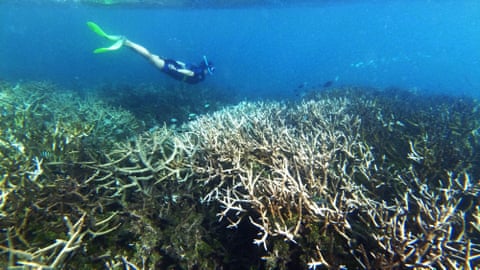
Great Barrier Reef’s worst bleaching leaves giant coral graveyard: ‘It looks as if it has been carpet bombed’
Scientists stunned by scale of destruction after summer of storm surges, cyclones and floods
Beneath the turquoise waters off Heron Island lies a huge, brain-shaped Porites coral that, in health, would be a rude shade of purplish-brown. Today that coral outcrop, or bommie, shines snow white.
Prof Terry Hughes, a coral bleaching expert at James Cook University, estimates this living boulder is at least 300 years old.
“If that thing had eyes it could have looked up and watched Captain Cook sail past,” he says, back on the pristine beach of this speck of an island 80km offshore at the southern end of the Great Barrier Reef .
It is not just Heron’s grand old bommie that is freshly bleached. The surrounding tangle of staghorn corals, or Acropora , are splashed in swathes of white, or painted a dappled mosaic of greens and browns that betray the algae and seaweeds growing over the freshly killed coral. Hughes estimates 90% of those branching corals are dead or dying.

Snorkelling above these blighted coral thickets evokes the imagery of forests annihilated by bushfires, or cities obliterated by missiles.
“It looks as if it has been carpet bombed,” says the Greens senator Peter Whish-Wilson, who has accompanied Hughes to Heron. “Like limbs strewn everywhere.”
Even Hughes, a man who has witnessed as much mass mortality of coral as any, looks shellshocked.
The Dublin-born, Townsville-based marine biologist already knew the coral ringing Heron had just experienced its worst recorded bleaching – and that this was no isolated event .
Last month the Australian Institute of Marine Science and the Great Barrier Reef Marine Park Authority released a report warning that the reef was experiencing “the highest levels of thermal stress on record”. The authority’s chief scientist, Dr Roger Beeden, spoke of extensive and uniform bleaching across the southern reefs, which had dodged the worst of much of the previous four mass bleaching events to blight the Great Barrier Reef since 2016.
Hughes saw in the institute’s aerial surveys results the most “widespread event and severe” bleaching event to date, not just in the south, but across much of the entire system – which stretches 2,300km up the Queensland coast.

But none of these metrics, it seems, could truly prepare him for the act of bearing witness to the unfolding calamity he has dedicated his life to preventing.
“It’s fucking awful,” the softly spoken scientist says, emerging from the ocean. “They said the bleaching was extensive and uniform. They didn’t say it was extensive, uniform and fucking awful.
“It’s a graveyard out there.”

Lethal hot water
The academic director of the University of Queensland research station on Heron, Dr Selina Ward, doesn’t mince words either. She describes this as “the year from hell”.
Storm surges washed away some of her favourite stands of corals, there have been outbreaks of coral-eating crown-of-thorns starfish, cyclones and floods. But these “multiple assaults” pale compared with this most “horrendous bleaching”.
The bleaching peaked in February and March. At the end of March, Ward visited 16 sites around Heron and nearby reefs, including around One Tree Island – a scientific reserve with “the maximum level of protection you can get”.
“It was terrible, the worst bleaching event I’ve ever seen,” she says. “In those 16 sites, every single one was severely bleached – and some of the corals were starting to die already.”
Her big question, though, is what is happening under the water right now.
Corals bleach when sustained exposure to warmer than average water causes them to expel the photosynthetic algae that give them colour – and from which the corals polyps obtain much of their nutrients.
A coral can die or recover from bleaching. The weeks that follow a bleaching event are a brief window in which scientists like Ward and Hughes can assess how many corals have starved without their symbiotic algae. In a few months, those newly dead corals will be covered in weed and beginning to be broken down into barren rubble piles – the time and cause of their demise will become more and more obscured.
The reef is now in that window, Ward says, where scientists can get into the water and observe the amount of bleached corals that – though left more vulnerable to disease and less fertile – might just regain colour and pull through. As well as those that will not.
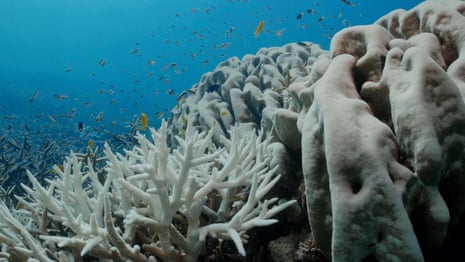
But bleaching is only one coral reaction to what Hughes says is perhaps better described as a hot water event. Some corals will simply “cook”. Others turn a vivid blue or neon yellow – a garish shade our research vessel’s skipper says has been widespread on the corals around Heron.
These, though dazzling, are also disconcerting – this fluorescence is a protein corals produce as a kind of sunscreen. It is not a very effective defence though. According to Hughes, most of these neon corals won’t survive.
“The irony is that it looks beautiful in death,” Whish-Wilson says of a fluorescent coral while he and Hughes wade through knee-deep water as the tide recedes around Heron and coral tips emerge from the water like bones.
after newsletter promotion
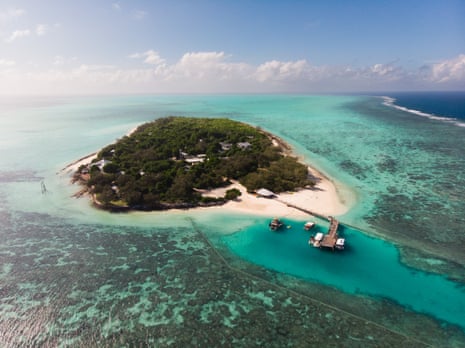
The unseen national emergency
After the summer of 2023-24, the Great Barrier Reef is awash in cruel irony and dissonance. The first strikes the traveller to Heron as its Islander catamaran departs its berth and rounds a canal into Gladstone’s harbour.
A hulking and rusty bow is slowly revealed as a bulk carrier connected, by crane-like loaders, to great mounds of crushed black earth. Behind it, another ship is being loaded with coal. And another behind that.
Then, as the catamaran rounds Curtis Island, it ducks and weaves its way through bulk carrier after bulk carrier, lurking outside the harbour like a school of sharks at the edge of a reef. On his phone’s shipping app, Hughes lists 43 of the steel leviathans.

Whish-Wilson says the flotilla speaks to a government having “a bet each way”.
“But you can’t have a future for fossil fuels and a future for a healthy reef,” he says. “You just can’t.”
Later, reflecting on a trip he already feels will haunt the rest of his life, the Greens healthy oceans spokesperson says this devastating bleaching should trigger Unesco to declare the Great Barrier Reef’s world heritage values as “in danger” and demand a visit from the federal environment minister, as well as a declaration of national emergency.
If this were a bushfire raging across thousands of kilometres, he says, that declaration would already have been made.
“But because it is in the ocean, it is out of mind, out of sight.”
Slim hope of recovery
Another of Heron’s incongruities is that, even amid such underwater devastation, it still harbours breathtaking beauty. Green sea turtles cruise above stands of broken coral, giant coral trout open their mouths and gills for electric blue cleaner wrasse, manta rays glide gracefully through the shallows.
Hughes first came here as a postdoctoral researcher in 1985 and has often returned. Now, as he prepares to leave Heron once more, he ponders the future of a natural wonder of the world to which he has given so much of his life.
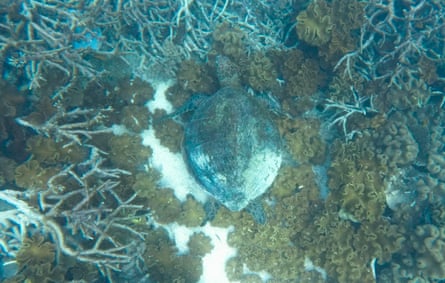
The 67-year-old has seen the coral ecosystems of the Great Barrier Reef degrade and knows that they are on the inexorable path of further decline. Yet, if global heating can be limited to well below 2C on pre-industrial levels , Hughes still believes it is possible to stabilise sea temperatures and allow those corals that survive to mount a slow recovery.
It is not a question of hope or resignation, he says, but “immediate action”.
Unless fossil fuel emissions are cut “ASAP”, he says, the corals of the world’s reefs will be replaced by something else, perhaps seaweed or sponges.
“There would still be a tropical ecosystem here,” Hughes says with a sweep of his hand. “But at some point we would have to say it is no longer a coral reef. We’d have to call it something else.”
So when will Hughes return to Heron to see what, if anything, recovers? Will he check on that grand old bommie, now snow white?
“I’m not sure I will come back,” he says.

And why not? To this, a long pause, as Hughes looks away and out at the ocean, the only sound a choked sob and the haunting wail of the black noddies that brood and swarm on this troubled coral cay.
“’Cause it’s so upsetting,” he says, eventually.
Not that Hughes plans on staying silent.
“I think scientists like me need to be as vocal as possible,” he says. “To show people what’s happening.”
- Great Barrier Reef
- Climate crisis
- Marine life
- Australian politics
Most viewed

COMMENTS
GALEX CORAL TOURS, Tonalá, Jalisco. 1,889 likes · 9 talking about this · 6 were here. Somos una Agencia con la Misión de brindar los mejores precios de la plaza, con la garantía de una Estadía...
¡PLAN PLATINUM! ️ ️ Conócelo y vive la experiencia GALEX CORAL TOURS. #vacacionesalalcancedetodos #Guayabitos #PlanPLATINUM
121 Followers, 233 Following, 26 Posts - See Instagram photos and videos from Galex Coral Tours (@galexcoraltours)
The latest Tweets from Galex Coral Tours (@GalexCoralTours). Agencia de viajes especializada en planes vacacionales accesibles y renta de autobuses....VACACIONES AL ALCANCE DE TODOS!!!
GALEX CORAL TOURS · Original audio
GALEX is the combination of the words Galesburg and Exhibit. What began as a regional exhibition has grown into a national competition and exhibition celebrating its 57th year. Open to artists working in all mediums, this year's juror, Jenny Chi, who is an active artist and educator and travels extensively in Italy, will award over $2,500 in ...
The Galaxea fascicularis (scientific name), commonly referred to as Galaxy coral, Tooth coral or Starbust coral, is a stony coral known for its unique appearance and aggressive nature.Native to the Indo-Pacific region, this species is admired for its intense coloration and challenging care. When considering Galaxea for an aquarium, it's essential to note that they possess sweeper tentacles ...
As their tentacles can extend at least 4 inches during the evening, ensure you leave at least 6 inches (12 inches recommended) between other corals otherwise they will start chemical warfare, and your Galaxea will most likely win…. Placement for your Galaxea coral also depends on the lighting you provide. When kept under moderate lighting ...
Support for Bike Walk Coral Gables' programming, including our self-guided tours, is generously provided by the Coral Gables Community Foundation and it's Foundation's Fall 2020 Grant Program, of which our organization was selected as a recipient. This award helps us further our mission to advocate for access, safety, and improved quality ...
A todo dar con Coral tours hacen un ambiente agradable, en ningún momento son groseros, todo lo contrario tienen una vibra fiestera y eso me agrada. En cuestión de que tengas tiempo de salir de vacaciones, les recomiendo. Sin van de vacaciones vayan con la mentalidad de divertirse y arriesgarse hacer algo distinto en su vida, no vayan a ...
GUIDED TOURS. The Coral Gables Museum (CGM) is the official Visitor Center for the City of Coral Gables, a planned community of the 1920s featuring Mediterranean style historic buildings, fountains, plazas and grand entrances surrounded by lush landscaping and Miami-Dade's most majestic tree canopy, earning it the nickname the City Beautiful.
Common Names: Galaxea coral, Tooth coral, Star coral, Crystal coral, Starburst coral, Brittle coral, Galaxy coral, Scalpel coral, Durian coral. Scientific Names: Galaxea fascicularis. Size: Individual polyps reach up to 6mm in diameter. Minimum Tank Size: 50 Gallons (189L) Aggression Level: Aggressive. Compatibility: Provide a wide berth around ...
4D3N HONGKONG PACKAGE 5: W/ FREE CITY TOUR & MACAU CITY TOUR 5* HOTELS. VISA ASSISTANCE. Client Feedback. Thank you for giving us good feedback. CONTACT US! 0917 653 1100; [email protected]; 5/F SM City Manila 1001 Manila, Philippines; FOLLOW US! Facebook; Tiktok; Instagram
Biltmore Hotel. 1200 Anastasia Avenue. Coral Gables, FL 33134. (855) 311-6903. Visit Website Get Directions. Posted on May 10, 2023 | Updated January 4, 2024.
GALEX CORAL TOURS was live. Video. Home
Best Art Tours in Coral Gables, FL - Wynwood Art Walk Tours, Lowe Art Museum, Miami's Best Graffiti Guide, Wynwood Buggies, Miami Culinary Tours, Miami Art Tours, Miami, By Locals Tours, Van Gogh The Immersive Experience, The Art of the Brick - An Exhibition of LEGO Art, Surreal 360 Exp.
Carved out of coral rock, Coral Gables' Venetian Pool is the largest freshwater swimming pool in the US. Popular with the locals, it features caves, bridges and waterfalls. Landmarks. Our hop-on, hop-off Big Bus Miami Tour allows you to hop off right outside the boutiques and artisanal stores of Merrick Park. Get your tickets online today.
April 27, 2024. Lace up your running shoes and load up your strollers for the Baptist Health Tour of the Gables 5K, 10K and Kids Dash on Saturday, April 27. The event hosted by the Coral Gables Chamber of Commerce starts at 6 a.m. with the race kicking off at 7 a.m. at Coral Gables City Hall, 405 Biltmore Way. April 27 2024 · 6:00 AM - 11:00 AM.
April 21: Bike and BBQ/Gables Cycle Day. Join us for the most popular bike tour of the year: a ride to Matheson Hammock Park and picnic at the historic pavilion. This tour leaves from the Coral Gables Youth Center (405 University Dr, Coral Gables, FL 33134). Presented in partnership with the City of Coral Gables and Dade Heritage Trust.
March 2, 2024. The 31st Villagers' Garden Tour will take place from 10 a.m. to 3 p.m. on Saturday, March 2, in the Coral Gables and High Pines area. The "Tropical Oasis" theme will be vividly on display in each specially curated garden. Villagers and garden experts will be on hand to explain the special features and plantings at each location.
As your exploration around the Sea of Galilee wraps up, the adventure through Israel's wonders continues with the Coral Travel & Tours, your partner in customizing unforgettable tours tailored to your unique interests. Whether you're drawn to intimate family tours, adventurous day trips, or comprehensive vacation tours, Coral Travel & Tours ...
March 17, 2024 · April 21, 2024. Coral Gables Museum, 285 Aragon Ave, Coral Gables, FL 33134. Recreation Arts/Culture Green Initiatives. Tickets and More Information. Hop on for fun, educational bike tours through The City Beautiful. They take place every third Sunday of the month. Each tour offers a different theme and route!
Scientists stunned by scale of destruction after summer of storm surges, cyclones and floods Beneath the turquoise waters off Heron Island lies a huge, brain-shaped Porites coral that, in health ...